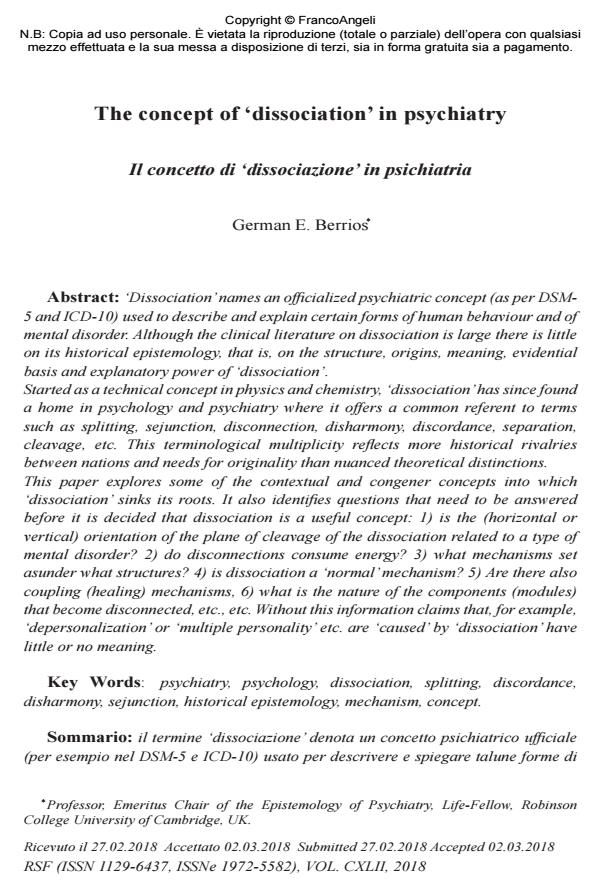The concept of ‘dissociation’ in psychiatry
Journal title RIVISTA SPERIMENTALE DI FRENIATRIA
Author/s German E. Berrios
Publishing Year 2018 Issue 2018/1
Language English Pages 22 P. 29-50 File size 1763 KB
DOI 10.3280/RSF2018-001003
DOI is like a bar code for intellectual property: to have more infomation
click here
Below, you can see the article first page
If you want to buy this article in PDF format, you can do it, following the instructions to buy download credits

FrancoAngeli is member of Publishers International Linking Association, Inc (PILA), a not-for-profit association which run the CrossRef service enabling links to and from online scholarly content.
‘Dissociation’ names an officialized psychiatric concept (as per DSM-5 and ICD-10) used to describe and explain certain forms of human behaviour and of mental disorder. Although the clinical literature on dissociation is large there is little on its historical epistemology, that is, on the structure, origins, meaning, evidential basis and explanatory power of ‘dissociation’. Started as a technical concept in physics and chemistry, ‘dissociation’ has since found a home in psychology and psychiatry where it offers a common referent to terms such as splitting, sejunction, disconnection, disharmony, discordance, separation, cleavage, etc. This terminological multiplicity reflects more historical rivalries between nations and needs for originality than nuanced theoretical distinctions. This paper explores some of the contextual and congener concepts into which ‘dissociation’ sinks its roots. It also identifies questions that need to be answered before it is decided that dissociation is a useful concept: 1) is the (horizontal or vertical) orientation of the plane of cleavage of the dissociation related to a type of mental disorder? 2) do disconnections consume energy? 3) what mechanisms set asunder what structures? 4) is dissociation a ‘normal’ mechanism? 5) Are there also coupling (healing) mechanisms, 6) what is the nature of the components (modules) that become disconnected, etc., etc. Without this information claims that, for example, ‘depersonalization’ or ‘multiple personality’ etc. are ‘caused’ by ‘dissociation’ have little or no meaning.
Keywords: Psychiatry, psychology, dissociation, splitting, discordance, disharmony, sejunction, historical epistemology, mechanism, concept.
German E. Berrios, The concept of ‘dissociation’ in psychiatry in "RIVISTA SPERIMENTALE DI FRENIATRIA" 1/2018, pp 29-50, DOI: 10.3280/RSF2018-001003